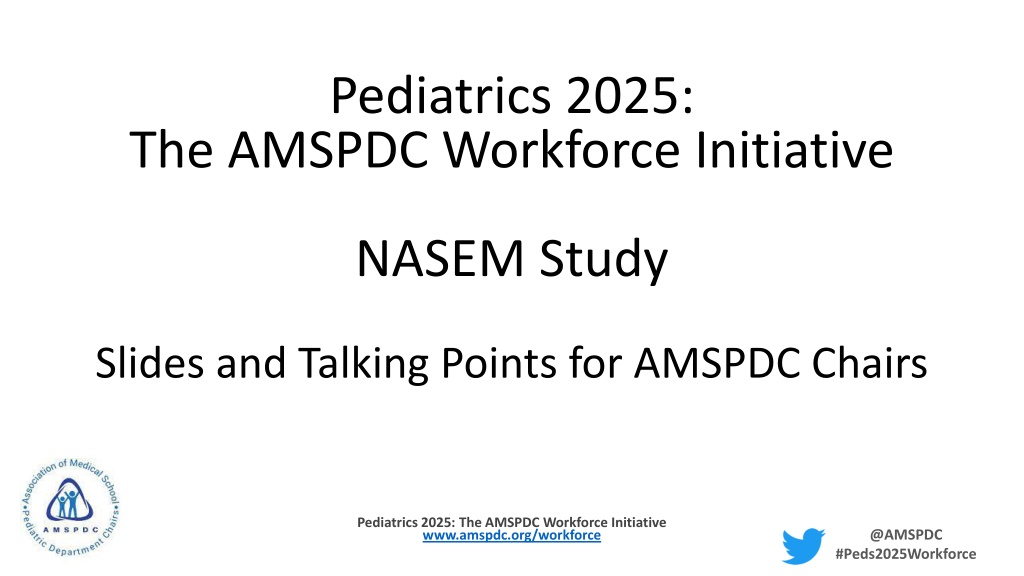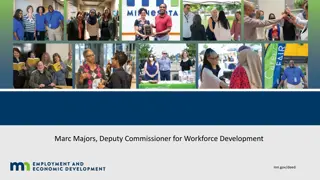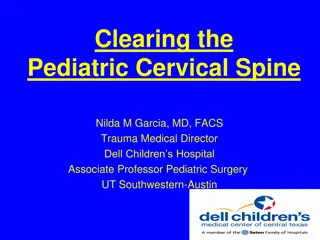Pediatric Workforce Initiative 2025 Presentation Highlights
Explore the key points of the Pediatrics 2025 AMSPDC Workforce Initiative, emphasizing the importance of investing in pediatric health care, the role of pediatric subspecialists, and the need for improved access to specialized care for children and adolescents. The presentation covers reasons to prioritize pediatric care, background data on matches and salaries, NASEM study findings, and recommendations for enhancing the pediatric subspecialty workforce.
Download Presentation

Please find below an Image/Link to download the presentation.
The content on the website is provided AS IS for your information and personal use only. It may not be sold, licensed, or shared on other websites without obtaining consent from the author. Download presentation by click this link. If you encounter any issues during the download, it is possible that the publisher has removed the file from their server.
E N D
Presentation Transcript
Pediatrics 2025: The AMSPDC Workforce Initiative NASEM Study Slides and Talking Points for AMSPDC Chairs Pediatrics 2025: The AMSPDC Workforce Initiative www.amspdc.org/workforce @AMSPDC #Peds2025Workforce
Discussion Points 1. Why invest in pediatric health care and pediatric subspecialists 2. Background data on the match and salary analysis 3. NASEM study findings and recommendations on the pediatric subspecialty workforce Pediatrics 2025: The AMSPDC Workforce Initiative www.amspdc.org/workforce @AMSPDC #Peds2025Workforce
Why Invest in Pediatric Health Care? 1. Children are our future A growing number of adult diseases have their onset during childhood Improving care to children will decrease overall health care costs and lead to healthier adults who contribute positively to society 2. Children now face many risks High rates of poverty. Children remain the poorest subgroup in the US Childhood adversity leads to poor health outcomes Children are uniquely vulnerable to health disparities related to race and socioeconomic status Children s mental health is in crisis 3. Children have been long-ignored by a health care system that has prioritized adults with chronic disease, often without any meaningful impact on adult outcomes Pediatrics 2025: The AMSPDC Workforce Initiative www.amspdc.org/workforce @AMSPDC #Peds2025Workforce
Why Invest in Pediatric Health Care? 4. Growing sophistication in diagnosis and treatment of pediatric diseases Genetic testing, genome sequencing Proteomics, transcriptomics, metabolomics Microbiome analysis 5. Increasing ability to provide curative therapy for pediatric disease Cell and gene therapy Bone marrow transplantation Other precision therapeutics 6. Increasing capacity to provide holistic care to children and families @AMSPDC #Peds2025Workforce Pediatrics 2025: The AMSPDC Workforce Initiative www.amspdc.org/workforce
Why Invest in Pediatric Subspecialists? 1. Pediatric subspecialists play critical role in delivering state-of-the-art care to children and adolescents 2. 10- 20% of the nation s children receive care from a pediatric specialist with more than one-third (38%) of children and adolescents having at least one chronic health condition 3. Pediatric subspecialists pursue research essential to advancing child and adolescent health 4. Care provided by non-pediatric subspecialists leads to poor health outcomes 5. Many patients live in areas of the country where there is little access to subspecialty care 6. Many subspecialties report long wait times for appointments, leading to treatment delays Pediatrics 2025: The AMSPDC Workforce Initiative www.amspdc.org/workforce @AMSPDC #Peds2025Workforce
Background Data Pediatrics 2025: The AMSPDC Workforce Initiative www.amspdc.org/workforce @AMSPDC #Peds2025Workforce
% MD Graduates Entering Pediatrics: 2008 - 2023 11 10.5 10 9.5 Percentage 9 8.5 8 7.5 7 2009 2010 2011 2012 2013 2014 2015 2016 2017 2018 2019 2020 2021 2022 2023 Match Year @AMSPDC #Peds2025Workforce Pediatrics 2025: The AMSPDC Workforce Initiative www.amspdc.org/workforce
Medical Student Applicants to Pediatrics ERAS Data Show a Steady Decline 2019 2020 2022 2023 2024 MD 2124 2204 2095 2058 1831 13.5% IMG 2125 2087 1940 1806 1769 16.8% DO 652 645 774 787 739 Total 4951 4936 4809 4651 4379 11.5% @AMSPDC #Peds2025Workforce Pediatrics 2025: The AMSPDC Workforce Initiative www.amspdc.org/workforce
Pediatric subspecialty fellowships with fewer applicants than positions in 2024 2024 cycle Adolescent Medicine Cardiology Child Abuse Critical Care Medicine Developmental Pediatrics Emergency Medicine Endocrinology Gastroenterology Hematology/Oncology Hospital Medicine Infectious Diseases Nephrology Neonatology Pulmonology Rheumatology Pediatrics 2025: The AMSPDC Workforce Initiative www.amspdc.org/workforce @AMSPDC #Peds2025Workforce
Pediatric Subspecialties Applicants per Position in 2024 # Applicants ERAS 2024 NRMP 2024 Per Position - 2024 Positions in Applicants 2023 Applicants Per Position Specialty Hospital Medicine Cardiology 133 184 124 179 1.07 1.03 1.17 1.08 More than 1 applicant per position Critical Care Neonatal Emergency 211 278 207 224 302 227 0.94 0.92 0.91 1.09 1.04 1.12 Approximately 0.9 applicants per position Adolescent Medicine Gastroenterology Hematology/Oncology Rheumatology Endocrinology Pulmonology Nephrology Child Abuse Developmental Peds Infectious Disease 28 93 129 32 62 51 41 12 28 36 34 125 184 52 100 86 73 21 49 77 0.82 0.74 0.70 0.62 0.62 0.59 0.56 0.57 0.57 0.47 0.74 1.12 0.89 0.72 0.65 0.72 0.62 0.65 0.69 0.62 Less than 0.9 applicant per position Applicant data is based on # of applicants who prefer that specialty from the ppreliminary 2024 NRMP Data. Results are compared to the 2023 Final NRMP Data Pediatrics 2025: The AMSPDC Workforce Initiative www.amspdc.org/workforce @AMSPDC #Peds2025Workforce 10
Pediatric subspecialty fellowship match results: Pediatric subspecialty fellowship match results: 2023 vs. 2024 2023 vs. 2024 2023 2024 Total positions filled 1536 1487 3.2% MD graduates 946 (61%) 899 (60%) DO graduates 226 (15%) 238 (16%) US IMG 135 (9%) 127 (8.5%) Non-US IMG 228 (15%) 222 (15%) @AMSPDC #Peds2025Workforce Pediatrics 2025: The AMSPDC Workforce Initiative www.amspdc.org/workforce
Catenaccio, Rochlin & Simon. Differences in Lifetime Earning Potential for Pediatric Subspecialists. Pediatrics 2021. Updated Pediatricc Salary Analysis Lifetime Relative NPV (in thousands of $) 2007 (Inflation adjusted) Medical Student Debt Graduate in 2008: 87% had educational debt mean debt burden $158 061 Graduate in 2019: 73% had educational debt mean debt burden $200,000 2018 Emergency Med Gastroenterology Pediatrics 2025: The AMSPDC Workforce Initiative www.amspdc.org/workforce Infectious Dis Nephrology General Peds Neonatology Heme-Oncology Rheumatology Pulmonary Endocrinology Critical Care Cardiology @AMSPDC #Peds2025Workforce
@AMSPDC #Peds2025Workforce Pediatrics 2025: The AMSPDC Workforce Initiative www.amspdc.org/workforce
National Academies Study Substantiated Major Concerns about the Future of the Pediatric Subspecialty Workforce Pediatrics 2025: The AMSPDC Workforce Initiative www.amspdc.org/workforce @AMSPDC #Peds2025Workforce
The Future Pediatric Subspecialty Physician Workforce Meeting the Needs of Infants, Children, and Adolescents www.nationalacademies.org/pediatric-subspecialties Pediatrics 2025: The AMSPDC Workforce Initiative www.amspdc.org/workforce @AMSPDC #Peds2025Workforce
NASEM Study Goals 1. Promote collaboration and the effective use of services between pediatric primary care clinicians and subspecialty physicians. 2. Reduce financial and payment disincentives to subspecialty careers 3. Enhance education, training, recruitment and retention. 4. Support the pediatric physician-scientist pathway Pediatrics 2025: The AMSPDC Workforce Initiative www.amspdc.org/workforce @AMSPDC #Peds2025Workforce
Promote collaboration and effective use of services between primary pediatric care clinicians and subspecialty physicians 1. Pediatrics has developed innovative models of care and emphasized evidence-based care delivery models Embedded pediatric specialists in primary care Team-based care 2. Public and private health insurance payers should adequately reimburse these evidence-based care delivery models 3. We need legislative advocacy, especially with CMS to accomplish this goal Telehealth across State lines E-Consults Incentivize general pediatrics to provide basic complex care to children Provide incentives for models that promote transitions to adult care @AMSPDC #Peds2025Workforce Pediatrics 2025: The AMSPDC Workforce Initiative www.amspdc.org/workforce
Reduce financial and payment disincentives to subspecialty careers 1. CMS Undervalues the Care of Children Physician reimbursement is driven by the assignment of relative value units (RVUs) Assignment of RVUs is developed by the RVS Update Committee (RUC), a committee formed by the AMA and has only one representative from the pediatric community Membership of the RUC is heavily weighted to adult and surgical disciplines As an example, An average hip replacement requires 90 minutes of surgical time and is assigned an RVU value of 21.24. A comprehensive outpatient pediatric visit according to CMS guidelines requires 40 to 60 minutes of care (but often involves more time at the visit and in follow up) and has an RVU value of approximately 4.0 @AMSPDC #Peds2025Workforce Pediatrics 2025: The AMSPDC Workforce Initiative www.amspdc.org/workforce
Reduce financial and payment disincentives to subspecialty careers 1. The average salary of a pediatrician is 25% less than a physician trained in adult medicine for the same subspecialty care. This leads to a loss of lifetime earnings of $1.2 million dollars compared to an adult specialist 2. To invest in children s health and address the factors that contribute to limited access to pediatric subspecialty care, Congress should allocate additional federal funding to increase payment for pediatric services 3. Within 5 years, Congress should provide federal funds to states to increase Medicaid payment rates for pediatric services to achieve or exceed parity with Medicare payment rates (see next slide for additional data on Medicaid to Medicare rates) These federal funds should be provided to all states, and the federally funded payment increases should be mandatory Pediatrics 2025: The AMSPDC Workforce Initiative www.amspdc.org/workforce @AMSPDC #Peds2025Workforce
Medicaid-to-Medicare Fee Index (2019) Source: Kaiser Family Foundation. Use this link for interactive map to view your State @AMSPDC #Peds2025Workforce Pediatrics 2025: The AMSPDC Workforce Initiative www.amspdc.org/workforce
Enhance education, training, recruitment, and retention 1. Pediatric departments, medical schools and health systems should develop, implement, and publicly report on plans and outcomes to attract, support, and retain a diverse pediatric subspecialty workforce 2. The responsible individuals and entities above should publicly report annual metrics on the demographics of their pediatric subspecialty workforce Pediatrics 2025: The AMSPDC Workforce Initiative www.amspdc.org/workforce @AMSPDC #Peds2025Workforce
Enhance education, training, recruitment, and retention 3. Congress should reform graduate medical education (GME) formulas and programs, including Medicare GME and Children s Hospital GME, to ensure equitable and sufficient support for pediatric GME. (See next slide) 4. Funding should be distributed to address priority pediatric workforce needs, such as increased inclusion of clinicians from underrepresented in medicine backgrounds, high-priority subspecialties, geographic shortages, and enhanced training for new models of care Pediatrics 2025: The AMSPDC Workforce Initiative www.amspdc.org/workforce @AMSPDC #Peds2025Workforce
Childrens Hospitals GME CHGME supports the training of half the nations pediatricians and most subspecialists CHGME funding per trainee is less than half of Medicare GME. Medicare GME funds grow 4% annually Actual and Projected CHGME Payments Compared to Medicare GME Payments per Resident Long-term goal is parity with Medicare GME Will decline to 46% of Medicare GME by 2026 if action is not taken Current funding is $385 million Full funding will require $735 million @AMSPDC #Peds2025Workforce 23 Pediatrics 2025: The AMSPDC Workforce Initiative www.amspdc.org/workforce
Enhance education, training, recruitment, and retention 5. AMSPDC should convene a multi-organization group to review and adjust educational and training curricula for pediatric residents and fellows. 6. The ABP, the AOBP and the ACGME should develop, implement, and evaluate distinct fellowship training pathways, including a 2-year option for those who aspire to a career with a primary focus on clinical care. Pediatrics 2025: The AMSPDC Workforce Initiative www.amspdc.org/workforce @AMSPDC #Peds2025Workforce
Support the pediatric physician-scientist pathway 1. Increase number of career development awards. 2. Fully fund the Pediatric Subspecialty Loan Repayment Program Congress should increase funding for the Pediatric Specialty Loan Repayment Program to $30 million as originally authorized (see next slide) and expand eligibility to include pediatric physician-scientists HRSA should focus on loan repayment for high-priority pediatric medical subspecialties as well as subspecialists from underrepresented in medicine and/or economically disadvantaged backgrounds Pediatrics 2025: The AMSPDC Workforce Initiative www.amspdc.org/workforce @AMSPDC #Peds2025Workforce
Pediatric Subspecialty Loan Repayment Program Authorized for $30 million for pediatric subspecialists with an additional $20 million for pediatric and adolescent behavioral health providers In 2022, Congress appropriated $5 million for this program, which included behavioral health care. In 2023, a total of $15 million was appropriated Provides up to $35K annually for up to 3 years to pediatric subspecialists who agree to practice in an underserved area @AMSPDC #Peds2025Workforce Pediatrics 2025: The AMSPDC Workforce Initiative www.amspdc.org/workforce
Support the pediatric physician-scientist pathway 3. The NIH and NICHD with input from the NIH s Scientific Workforce Diversity Office should create and maintain a publicly available central repository for qualitative and quantitative data on pediatric physician scientists funding and success throughout their careers 4. Quantitative data should include: Funding rates of career development and subsequent awards Tracking of research careers by demographic factors, such as sex/gender, race, ethnicity, disability status, geography, type of science across the research continuum Data on successful researchers and those who leave the research track Pediatrics 2025: The AMSPDC Workforce Initiative www.amspdc.org/workforce @AMSPDC #Peds2025Workforce
1. Slides reviewed and prepared by Laura Degnon, CAE Joe St Geme, MD Bob Vinci, MD 2. For comments, questions or suggestions feel free to email. laura@amspdc.org stgemeiiij@chop.edu bvinci@bu.edu Pediatrics 2025: The AMSPDC Workforce Initiative www.amspdc.org/workforce @AMSPDC #Peds2025Workforce























